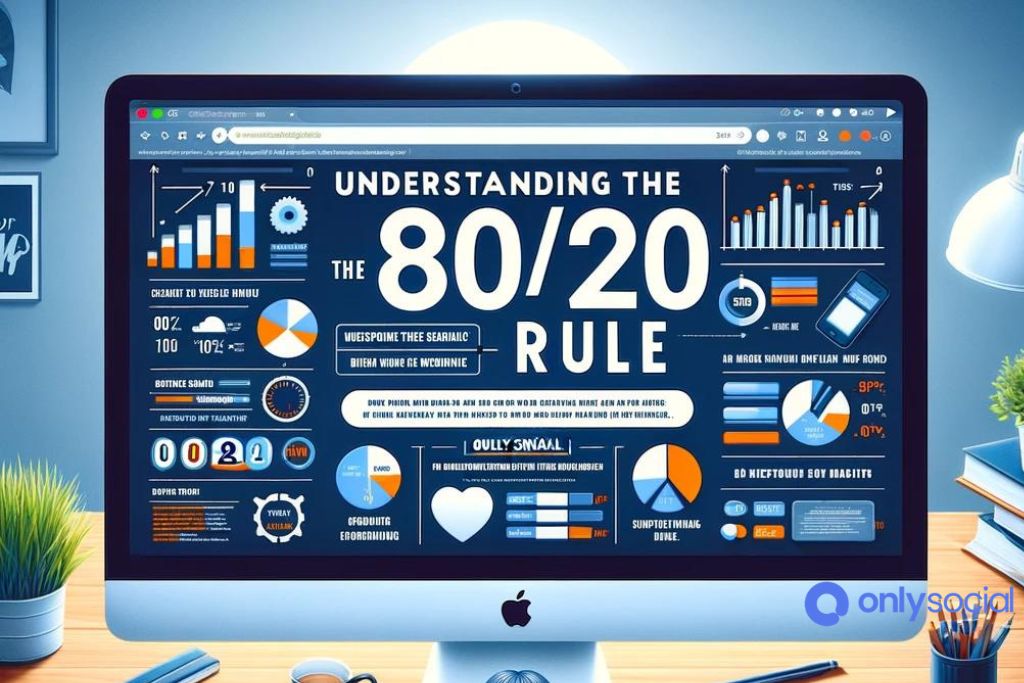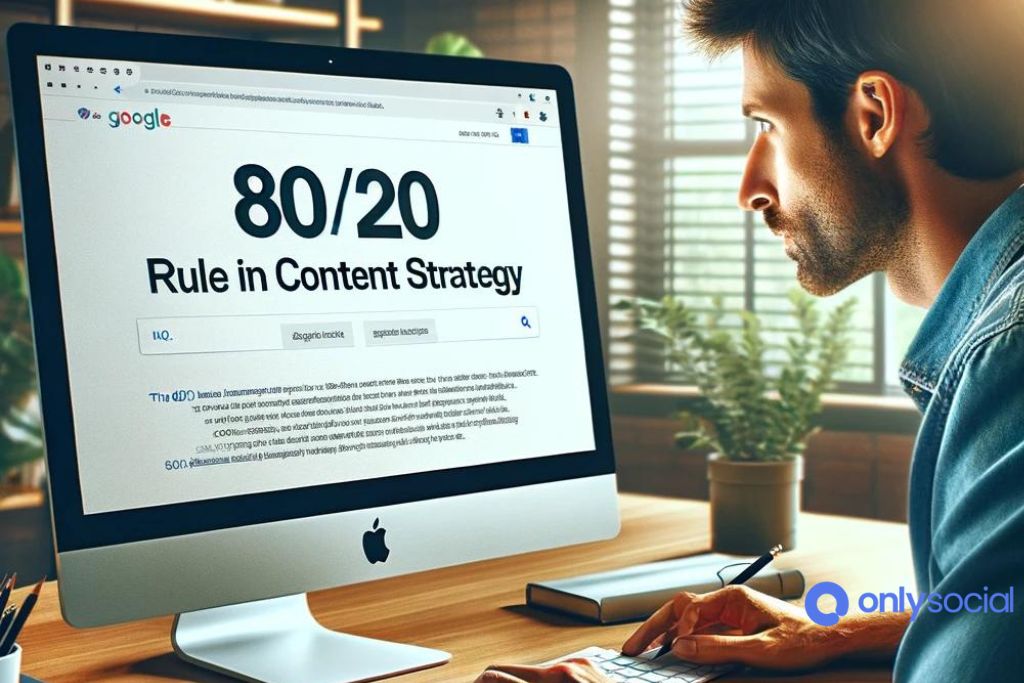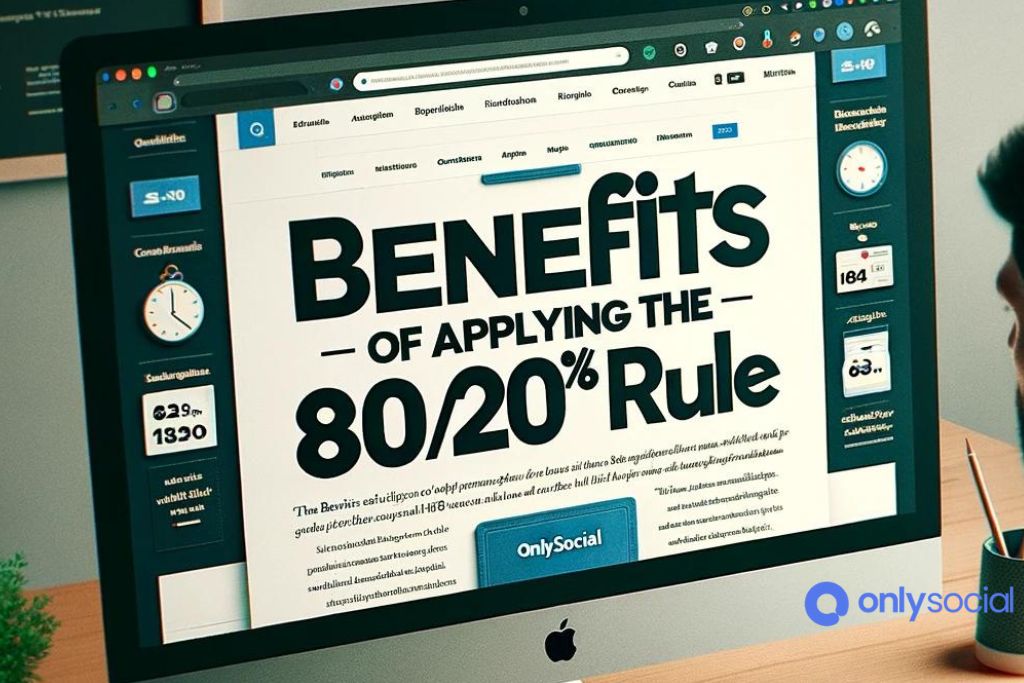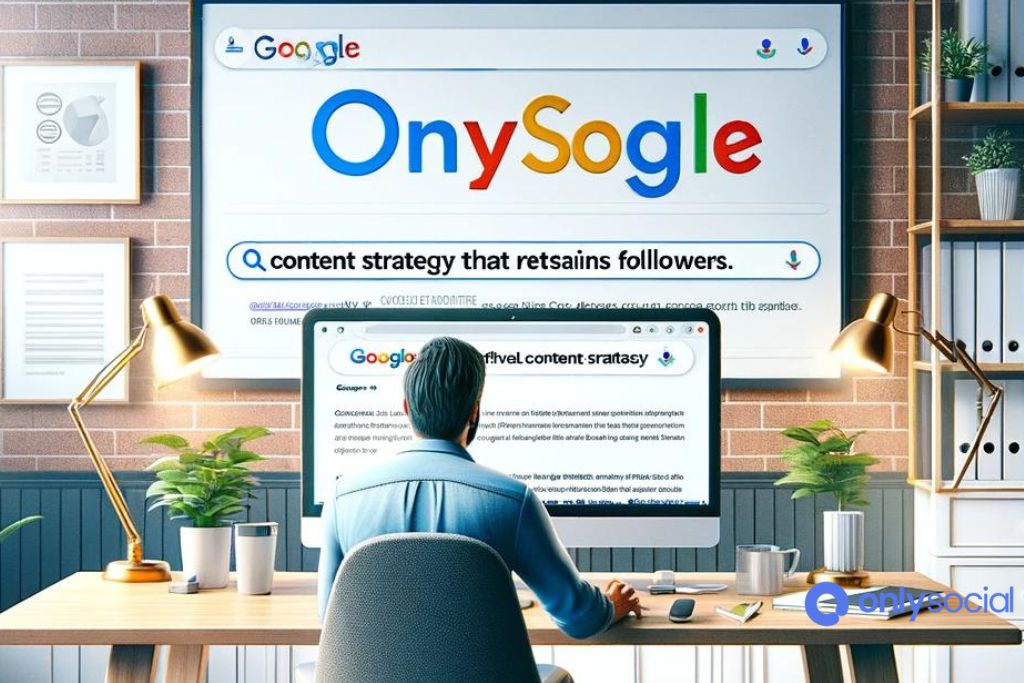The 80/20 Rule, also known as the Pareto Principle, has long been a guiding light in business, economics, and productivity circles, illustrating how a small amount of effort can often lead to a large portion of the results. When applied to content strategy, this rule becomes an invaluable framework for creators and marketers aiming to engage and retain their audience effectively. The essence of the 80/20 Rule in content strategy lies in striking the perfect balance between value-driven content and promotional messages, ensuring that followers remain engaged, informed, and entertained, while still being exposed to the brand’s offerings.
At its core, implementing the 80/20 Rule in content strategy involves dedicating 80% of your efforts to crafting content that genuinely interests and benefits your audience—be it through educational posts, insightful articles, or entertaining videos. The remaining 20% is then focused on directly promoting your products, services, or brand. This approach not only respects the intelligence and interests of your audience but also fosters a sense of trust and loyalty, key ingredients for long-term follower retention.
This article delves into the nuances of the 80/20 Rule in content strategy, offering a roadmap for creators and marketers who wish to harness the power of this principle to cultivate a vibrant, engaged community around their brand. By understanding and applying the insights shared here, you’ll be well-equipped to create a content strategy that not only attracts followers but keeps them coming back for more.
Table of Contents
- 1 Understanding the 80/20 Rule
- 2 The 80/20 Rule in Content Strategy
- 3 Benefits of Applying the 80/20 Rule to Your Content Strategy
- 4 Strategies for Implementing the 80/20 Rule in Your Content Plan
- 5 Challenges and Solutions in Implementing The 80/20 Rule in Content Strategy
- 5.0.1 Challenge 1: Identifying Value-Driven Content
- 5.0.2 Challenge 2: Balancing Promotional and Informative Content
- 5.0.3 Challenge 3: Consistency in Content Quality and Engagement
- 5.0.4 Challenge 4: Measuring the Impact of The 80/20 Rule
- 5.0.5 Challenge 5: Adapting to Audience Changes and Platform Evolution
- 6 BONUS
- 7 Frequently Asked Questions
- 7.0.1 What is the 80/20 Rule in Content Strategy?
- 7.0.2 How can I determine what content my audience considers value-driven?
- 7.0.3 Does the 80/20 Rule in Content Strategy apply to all types of businesses?
- 7.0.4 How do I integrate the 80/20 Rule in Content Strategy with my overall marketing strategy?
- 7.0.5 Can the 80/20 Rule in Content Strategy change based on platform or medium?
- 7.0.6 How often should I review and adjust my content strategy based on the 80/20 Rule?
- 7.0.7 Is it possible to apply the 80/20 Rule in Content Strategy too rigidly?
Understanding the 80/20 Rule

Understanding the 80/20 Rule is pivotal when devising an effective content strategy. Known as the Pareto Principle, this rule suggests that 80% of effects come from 20% of causes. Initially observed in economics, where it was noted that 80% of a country’s wealth was owned by 20% of its population, the principle has been applied across various fields, demonstrating its versatility and effectiveness. In the realm of content strategy, the 80/20 Rule underscores a crucial balance between value-driven and promotional content, guiding creators on how to retain and engage their audience efficiently.
Historical Background and Origin
The 80/20 Rule was named after Vilfredo Pareto, an Italian economist who, in the late 19th century, observed that 80% of Italy’s land was owned by 20% of the population. This observation led him to explore other areas in economics and society, finding the rule surprisingly applicable in various contexts. Over time, this principle has been embraced by businesses and individuals alike, seeking to optimize productivity and results.
General Application Across Industries
Beyond economics, the 80/20 Rule has been found relevant in health care, quality management, and customer service, among others. In each case, the principle helps identify the most impactful elements of a system, allowing for focused improvement efforts. For instance, businesses often find that 80% of their sales come from 20% of their customers, guiding them to tailor their services or products to this crucial demographic.
The 80/20 Rule in Content Strategy
When applied to content strategy, the 80/20 Rule encourages a focus on creating content that primarily provides value to the audience. This translates to an optimal balance where 80% of content aims to inform, educate, or entertain, leaving 20% for promotional activities. This approach not only helps in building a loyal following but also establishes a brand’s authority in its niche.
- Value-driven Content: This includes educational articles, how-to guides, entertaining videos, and any other content that offers intrinsic value to the reader or viewer without directly selling a product or service.
- Promotional Content: This encompasses content that aims to directly promote or sell a product or service. While necessary, it should be used sparingly to avoid overwhelming or alienating the audience.
By leveraging the 80/20 Rule in content strategy, creators and marketers can ensure that their efforts are more likely to engage their target audience effectively. This balance is crucial in retaining followers, as audiences are more inclined to stay engaged with brands that provide substantial value beyond mere sales pitches. Understanding and applying this rule can lead to a more robust and follower-centric content strategy, driving both engagement and loyalty.
The 80/20 Rule in Content Strategy

The 80/20 Rule, also known as the Pareto Principle, is a powerful concept that can transform your content strategy and significantly enhance follower retention. When applied to content marketing, this rule suggests that 80% of your content should focus on delivering value to your audience—through information, education, or entertainment—while the remaining 20% can be used for promotional purposes. This balance ensures that your followers remain engaged and loyal, rather than feeling overwhelmed by constant sales pitches.
Understanding the Balance
The crux of the 80/20 rule in content strategy lies in finding the right balance between value-driven and promotional content. Value-driven content is designed to meet the needs and interests of your audience, answering their questions, solving their problems, or simply providing entertainment. This approach not only builds trust with your followers but also establishes your brand as a thought leader in your industry.
On the other hand, promotional content aims to convert followers into customers by highlighting your products or services. While this is crucial for driving sales, overemphasizing promotional messages can deter your audience. The 80/20 rule ensures that promotional content is carefully woven into your overall content strategy without overshadowing the value you offer.
Applying the 80/20 Rule
To effectively implement the 80/20 rule in your content strategy, start by analyzing your audience’s preferences and behaviors. Identify the types of content that resonate most with them and consider how you can produce more of it. This might involve creating informative blog posts, engaging videos, helpful guides, or entertaining social media content.
Once you have a clear understanding of the value-driven content your audience desires, allocate 20% of your content calendar for promotional messages. These should be strategically placed to coincide with product launches, sales, or other key events. Ensure that even your promotional content offers some form of value, whether it’s exclusive discounts, insightful product information, or compelling storytelling.
Examples of Success
Many brands have successfully employed the 80/20 rule in their content strategies, resulting in increased follower engagement and loyalty. For example, a lifestyle brand might share a series of blog posts on wellness tips (value-driven content) and intersperse these with announcements about their new wellness product line (promotional content). This strategy keeps the audience engaged with the brand’s content ecosystem, making them more receptive to promotional messages when they appear.
The 80/20 rule in content strategy is not a rigid formula but a flexible guideline to ensure your content marketing efforts are balanced and effective. By focusing on creating content that genuinely serves your audience’s needs while strategically incorporating promotional elements, you can build a loyal following and drive business success.
Benefits of Applying the 80/20 Rule to Your Content Strategy

Integrating the 80/20 rule into your content strategy can have a transformative impact on how your audience engages with your brand and can significantly enhance your online presence. Here are some of the key advantages of adopting this approach:
Enhanced Audience Engagement and Follower Retention
The core premise of the 80/20 rule in content strategy emphasizes delivering value first. When 80% of your content focuses on informing, educating, or entertaining your audience without expecting anything in return, you foster a relationship built on trust and value. This approach not only increases the likelihood of your content being shared and commented on but also significantly boosts follower retention, as followers are more inclined to stay connected with brands that prioritize their needs and interests.
Improved Brand Image and Authority
The strategic distribution of content as suggested by the 80/20 rule in content strategy positions your brand as an authority in your niche. By focusing the majority of your efforts on producing content that adds value to your audience’s life, you naturally elevate your brand’s image. This is because you’re seen as a contributor to your community, rather than just another entity vying for sales. This perception is invaluable for long-term brand building and authority establishment.
Increased Conversion Rates with Less Promotional Content
Contrary to what many might believe, reducing the direct promotional content and focusing on value-driven content can actually lead to higher conversion rates. This aspect of the 80/20 rule in content strategy demonstrates that when your audience feels educated and valued, they are more likely to make purchases based on trust and brand loyalty. Essentially, by not overwhelming your audience with sales pitches, the 20% of your content that is promotional becomes far more effective.
Case Studies Showcasing the Impact on Follower Growth and Engagement
Real-world applications of the 80/20 rule in content strategy reveal its effectiveness. Brands across various industries have seen remarkable improvements in follower growth, engagement rates, and even direct sales conversions. These case studies not only serve as proof of concept but also provide actionable insights and inspiration for others looking to refine their content strategy. They illustrate the tangible benefits that can be achieved when brands prioritize the needs and interests of their audience through the strategic application of the 80/20 rule.
Adopting the 80/20 rule in your content strategy offers a multitude of benefits, from improved engagement and brand perception to increased conversion rates. It encourages a focus on creating meaningful connections with your audience, leading to sustained growth and success in the digital landscape.
Strategies for Implementing the 80/20 Rule in Your Content Plan
Understanding and implementing “The 80/20 Rule in Content Strategy” can significantly enhance your content’s effectiveness and your audience’s engagement. This section delves into practical strategies to effectively integrate the 80/20 rule into your content plan, ensuring a balance between value-driven and promotional content.
Identifying Value-Driven Content That Resonates With Your Audience
To apply the 80/20 rule, it’s crucial to first understand what types of content are most valuable to your audience. This involves:
- Audience Analysis: Use analytics tools to monitor which content types (blog posts, videos, infographics) and topics receive the most engagement.
- Feedback Collection: Directly ask your audience through surveys or social media polls about their preferences and needs.
- Competitor Research: Look at what content is working for similar brands or influencers in your niche.
| Method | Tool/Approach | Purpose |
|---|---|---|
| Audience Analysis | Google Analytics, Social Media Insights | Identify popular content formats and topics |
| Feedback Collection | Surveys, Polls | Gather direct input on audience preferences |
| Competitor Research | BuzzSumo, SimilarWeb | Benchmark against successful content in your industry |
Creating Engaging and Informative Content
Once you know what your audience prefers, focus on creating content that educates, entertains, or informs:
- Content Diversification: Mix formats such as blog articles, videos, and infographics to cover topics comprehensively.
- Storytelling: Incorporate stories and real-life examples to make informational content more engaging.
- Expert Contributions: Collaborate with industry experts or influencers to add credibility and depth to your content.
Best Practices for Promotional Content
Promotional content, while limited to 20%, is still crucial. Make it impactful by:
- Value Integration: Ensure even promotional content offers value, such as tutorials on using your products or services.
- Soft Sell Approach: Focus on how your offerings solve problems or enhance the user’s life, rather than hard-selling.
- Timing and Context: Align promotional content with relevant events, holidays, or audience needs to increase relevance.
Tools and Resources for Effective Content Strategy
Utilizing the right tools can streamline the implementation of the 80/20 rule in your content strategy:
- Content Calendar Tools: Plan and visualize your content distribution with tools like Trello or Asana.
- Analytics Tools: Measure the impact of your content strategy with Google Analytics and social media analytics.
- SEO Tools: Use SEMrush or Ahrefs to research keywords and topics that attract organic traffic.
Implementing the 80/20 rule in content strategy requires a deep understanding of your audience’s preferences, a commitment to creating high-quality, value-driven content, and strategic planning of promotional efforts. By following these strategies and utilizing the recommended tools, you can create a content plan that not only engages and retains followers but also supports your overall marketing objectives.
Challenges and Solutions in Implementing The 80/20 Rule in Content Strategy
Challenge 1: Identifying Value-Driven Content
Solution: To effectively apply The 80/20 Rule in your content strategy, start by conducting audience research to understand what truly engages your followers. Utilize analytics tools to measure interaction rates, shares, and comments on existing content. This data provides insights into the topics and formats your audience finds valuable. Also, encourage feedback through surveys or direct engagement to refine your understanding of audience preferences.
Challenge 2: Balancing Promotional and Informative Content
Solution: Striking the right balance requires meticulous planning and experimentation. Create a content calendar that schedules promotional content strategically, ensuring it doesn’t overshadow educational or entertaining posts. Monitor audience response to adjust the ratio as needed, aiming for a mix that supports both business objectives and audience needs.
Challenge 3: Consistency in Content Quality and Engagement
Solution: Maintaining high-quality content while following The 80/20 Rule in Content Strategy can be daunting. To address this, develop a content creation framework that outlines standards for quality and engagement. Invest in training for your content team on storytelling and audience engagement techniques. Additionally, repurpose high-performing content across different platforms and formats to maximize reach and efficiency.
Challenge 4: Measuring the Impact of The 80/20 Rule
Solution: The effectiveness of The 80/20 Rule in Content Strategy should be evaluated through both qualitative and quantitative metrics. Set clear KPIs related to engagement, conversion, and follower growth. Use social media and web analytics tools to track these metrics over time. Adjust your strategy based on these insights, focusing on what works best for your audience.
Challenge 5: Adapting to Audience Changes and Platform Evolution
Solution: Audience preferences and social media platforms evolve, which can affect the applicability of The 80/20 Rule in Content Strategy. Stay informed on trends and platform changes by subscribing to industry newsletters and attending relevant webinars. Regularly reassess your audience’s needs and preferences by analyzing engagement data and seeking direct feedback. Flexibility and adaptability are key to sustaining success with The 80/20 Rule in your content strategy.
Implementing The 80/20 Rule in Content Strategy offers significant benefits but comes with its set of challenges. By focusing on solutions that prioritize audience engagement, content quality, and strategic flexibility, you can overcome these hurdles and create a content strategy that not only retains but also grows your follower base.
BONUS
Incorporating the 80/20 rule into your content strategy is crucial for retaining followers. This principle suggests that 80% of your content should inform, educate, or entertain your audience, while only 20% should directly promote your products or services. By following this guideline, you can create a balanced and engaging online presence that fosters trust and loyalty among your followers.
Leverage OnlySocial’s Post Planning and Scheduling function to seamlessly integrate the 80/20 rule into your content strategy. With the ability to plan and schedule posts across all social networks, manage unlimited social profiles, and enjoy unlimited posting, OnlySocial ensures that your content mix remains balanced and effective. Try it out risk-free with a commitment-free 7-day trial today.
Frequently Asked Questions
What is the 80/20 Rule in Content Strategy?
The 80/20 rule, or Pareto Principle, when applied to content strategy, suggests that 80% of your content should focus on delivering value to your audience through education, entertainment, or information, while the remaining 20% can be dedicated to promotional content. This balance helps in retaining followers by consistently providing content that they find useful and engaging.
How can I determine what content my audience considers value-driven?
To identify value-driven content, analyze engagement metrics on your existing content to see what resonates most with your audience. Surveys, direct feedback, and social media interactions are also great ways to understand your audience’s preferences. Tools like Google Analytics and social media insights can provide quantitative data on content performance.
Does the 80/20 Rule in Content Strategy apply to all types of businesses?
Yes, the 80/20 rule can be adapted to fit the content strategy of various types of businesses, from B2B to B2C sectors. The key is to understand your specific audience’s needs and preferences and create content that addresses those while also aligning with your business goals.
How do I integrate the 80/20 Rule in Content Strategy with my overall marketing strategy?
Integrating the 80/20 rule into your overall marketing strategy involves planning your content calendar to ensure that 80% of your output is value-driven, with the rest allocated to promotional content. This integration should also align with your sales goals, product launches, and other marketing initiatives to create a cohesive strategy that supports business objectives.
Can the 80/20 Rule in Content Strategy change based on platform or medium?
Yes, the application of the 80/20 rule can vary based on the platform or medium. For instance, platforms like LinkedIn might favor more professional and educational content, while Instagram might be more suited for visually engaging and entertaining content. The principle remains the same, but the content type and presentation might change.
How often should I review and adjust my content strategy based on the 80/20 Rule?
It’s advisable to review and adjust your content strategy regularly, at least quarterly, to ensure it remains effective. Pay attention to changes in audience behavior, platform algorithms, and your own business goals. Regular analysis helps in refining your approach to maintaining the 80/20 balance and achieving optimal engagement.
Is it possible to apply the 80/20 Rule in Content Strategy too rigidly?
While the 80/20 rule serves as a guideline for balancing content, it’s essential to remain flexible. Audience preferences and social media landscapes evolve, so being too rigid can hinder performance. Adjust the ratio as needed based on feedback and performance metrics to stay aligned with your audience’s needs and interests.




